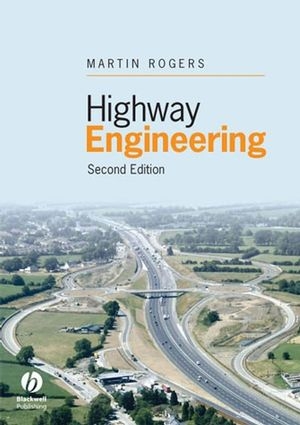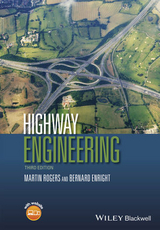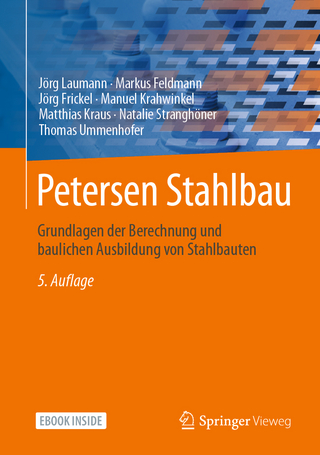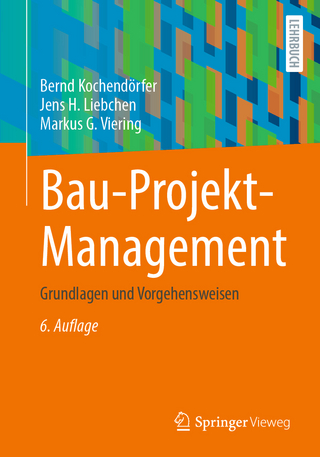
Highway Engineering
Wiley-Blackwell (an imprint of John Wiley & Sons Ltd) (Verlag)
978-1-4051-6358-3 (ISBN)
- Titel erscheint in neuer Auflage
- Artikel merken
com/rogers
Martin Rogers BE, MEngSc, PhD, BA(Public Ad), CEng, MICE, MRTPI, Chartered Engineer and Chartered Town Planner, received his professional education at University College Dublin and the Institute of Public Administration, Dublin. He has worked in private practice and as a senior local authority engineer and was a member of the Dublin Transport Initiative Study Team that devised the current transportation plan for the Dublin city region. He joined the permanent staff at the Dublin Institute of Technology in 1993 and is currently a Senior Lecturer in the Department of Civil and Structural Engineering. He has previously co-written one postgraduate and one undergraduate text on project appraisal methods and has published technical papers in a number of internationally recognised engineering, construction, planning and operational research journals.
1 The Transportation Planning Process . 1.1 Why are highways so important?. 1.2 The administration of highway schemes. 1.3 Sources of funding. 1.4 Highway planning. 1.4.1 Introduction. 1.4.2 Travel data. 1.4.3 Highway planning strategies. 1.4.4 Transportation studies. 1.5 The decision-making process in highway and transport planning. 1.5.1 Introduction. 1.5.2 Economic assessment. 1.5.3 Environmental assessment. 1.5.4 Public consultation. 1.6 Summary. 1.7 References. 2 Forecasting Future Traffic Flows . 2.1 Basic principles of traffic demand analysis. 2.2 Demand modelling. 2.3 Land use models. 2.4 Trip generation. 2.5 Trip distribution. 2.5.1 Introduction. 2.5.2 The gravity model. 2.5.3 Growth factor models. 2.5.4 The Furness method. 2.6 Modal split. 2.7 Traffic assignment. 2.8 A full example of the four-stage transportation modelling process. 2.8.1 Trip production. 2.8.2 Trip distribution. 2.8.3 Modal split. 2.8.4 Trip assignment. 2.9 Concluding comments. 2.10 References. 3 Scheme Appraisal for Highway Projects . 3.1 Introduction. 3.2 Economic appraisal of highway schemes. 3.3 Cost-benefit analysis. 3.3.1 Introduction. 3.3.2 Identifying the main project options. 3.3.3 Identifying all relevant costs and benefits. 3.3.4 Economic life, residual value and the discount rate. 3.3.5 Use of economic indicators to assess basic economic viability. 3.3.6 Highway CBA worked example. 3.3.7 COBA. 3.3.8 Advantages and disadvantages of cost-benefit analysis. 3.4 Payback analysis. 3.5 Environmental appraisal of highway schemes. 3.6 The new approach to appraisal (NATA). 3.7 Summary. 3.8 References. 4 Basic elements of highway traffic analysis . 4.1 Introduction. 4.2 Surveying road traffic. 4.2.1 Introduction. 4.2.2 Vehicle surveys. 4.2.3 Speed surveys. 4.2.4 Delay / queuing surveys. 4.2.5 Area wide surveys. 4.3 Journey Speed and travel time surveys. 4.3.1 Introduction. 4.3.2 The moving observer method. 4.4 Speed, flow and density of a stream of traffic. 4.4.1 Speed-density relationship. 4.4.2 Flow - density relationship. 4.4.3 Speed - Flow Relationship. 4.5 Headway distributions in highway traffic flow. 4.5.1 Introduction. 4.5.2 Negative exponential highway distribution. 4.5.3 Limitations of Poisson system for modelling headway. 4.6 Queuing Analysis. 4.6.1 Introduction. 4.6.2 The D/D/1 Queuing Model. 4.6.3 The M/D/1 Queuing Model. 4.6.4 The M/M/1 Queuing Model. 4.6.5 The M/M/N Queuing Model. 4.7 References. 5 Determining the capacity of a highway . 5.1 Introduction. 5.2 The 'Level of Service' Approach. 5.2.1 Introduction. 5.2.2 Some definitions. 5.2.3 Maximum service flow rates for multilane highways. 5.2.4 Maximum service flow rates for 2-lane highways. 5.2.5 Sizing a road using the Highway Capacity Manual Approach. 5.3 The UK Approach for rural roads. 5.3.1 Introduction. 5.3.2 Estimation of AADT for a rural road in its year of opening. 5.4 The UK Approach for Urban Roads. 5.4.1 Introduction. 5.4.2 Forecast flows on urban roads. 5.5 Expansion of 12 and 16 hour traffic counts into AADT flows. 5.6 Concluding Comments. 5.7 References. 6 The Design of Highway Intersections . 6.1 Introduction. 6.2 Deriving design reference flows from baseline traffic figures. 6.2.1 Existing junctions. 6.2.2 New junctions. 6.2.3 Short-term variations in flow. 6.2.4 Conversion of AADT to highest hourly flows. 6.3 Major/minor priority intersections. 6.3.1 Introduction. 6.3.2 Equations for determining capacities and delays. 6.3.3 Geometric layout details. 6.4 Roundabout intersections. 6.4.1 Introduction. 6.4.2 Types of roundabout. 6.4.3 Traffic capacity at roundabouts. 6.4.4 Geometric details. 6.5 Basics of traffic signal control: optimisation and delays. 6.5.1 Introduction. 6.5.2 Phasing at a signalised intersection. 6.5.3 Saturation flow. 6.5.4 Effective green time. 6.5.5 Optimum cycle time. 6.5.6 Average vehicle delays at the approach to a signalised intersection. 6.5.7 Average queue lengths at the approach to a signalised intersection. 6.5.8 Signal linkage. 6.6 Concluding remarks. 6.7 References. 7 Geometric Alignment and Design . 7.1 Basic physical elements of a highway. 7.2 Design speed, stopping and overtaking sight distances. 7.2.1 Introduction. 7.2.2 Urban roads. 7.2.3 Rural roads. 7.3 Geometric parameters dependent on design speed. 7.4 Sight distances. 7.4.1 Introduction. 7.4.2 Stopping sight distance. 7.4.3 Overtaking sight distance. 7.5 Horizontal alignment. 7.5.1 General. 7.5.2 Deriving the minimum radius equation. 7.5.3 Horizontal curves and sight distances. 7.5.4 Transitions. 7.6 Vertical alignment. 7.6.1 General. 7.6.2 K values. 7.6.3 Visibility and comfort criteria. 7.6.4 Parabolic formula. 7.6.5 Crossfalls. 7.6.6 Vertical crest curve design and sight distance requirements. 7.6.7 Vertical sag curve design and sight distance requirements. 7.7 References. 8 Highway Pavement Materials and Design . 8.1 Introduction. 8.2 Soils at subformation level. 8.2.1 General. 8.2.2 CBR test. 8.2.3 Determination of CBR using plasticity index. 8.3 Subbase and capping. 8.3.1 General. 8.3.2 Thickness design. 8.3.3 Grading of subbase and capping. 8.4 Traffic loading. 8.5 Pavement deterioration. 8.5.1 Flexible pavements. 8.5.2 Rigid pavements. 8.6 Materials within flexible pavements. 8.6.1 Bitumen. 8.6.2 Surface dressing and modified binders. 8.6.3 Recipe specifications. 8.6.4 Coated macadams. 8.6.5 Asphalts. 8.6.6 Aggregates. 8.6.7 Construction of bituminous road surfacings. 8.7 Materials in rigid pavements. 8.7.1 General. 8.7.2 Concrete slab and joint details. 8.7.3 Reinforcement. 8.7.4 Construction of concrete road surfacings. 8.7.5 Curing and skid resistance. 8.8 References. 9 Structural Design of Pavement Thickness . 9.1 Introduction. 9.2 Flexible pavements. 9.2.1 General. 9.2.2 Road Note. 9.2.3 LR1132. 9.2.4 HD 26/0. 9.3 Rigid pavements. 9.3.1 Jointed concrete pavements (URC and JRC). 9.3.2 Continuously reinforced concrete pavements (CRCP). 9.4 References. 10 Pavement Maintenance . 10.1 Introduction. 10.2 Forms of maintenance. 10.3 Compiling information on the pavement's condition. 10.4 Deflection versus pavement condition. 10.5 Overlay design for bituminous roads. 10.6 Overlay design for concrete roads. 10.6.1 Bitumen-bound overlays placed over rigid pavements. 10.6.2 Concrete overlays. 10.7 Sideway force coefficient routine investigation machine (SCRIM). 10.7.1 Wet skidding. 10.7.2 Using SCRIM. 10.7.3 Grip tester. 10.8 References. 11 The highway engineer and the development process . 11.1 Introduction. 11.2 Transport Assessments. 11.2.1 Introduction. 11.2.2 Identifying the need for an assessment. 11.2.3 Preparing a Transport Assessment. 11.2.4 Final Comment. 11.3 Travel Plans. 11.3.1 Introduction. 11.3.2 Thresholds. 11.3.3 Legal basis. 11.3.4 Main Requirements of a Section 106 Agreement Travel Plan. 11.3.5 Mobility Management Plans in Ireland. 11.4 Road Safety Audits. 11.4.1 Definition. 11.4.2 Stages of Audit. 11.4.3 Safety principles. 11.4.4 The Safety Audit Process. 11.4.5 Risk analysis. 11.4.6 Conclusions. 11.5 References
| Erscheint lt. Verlag | 6.6.2008 |
|---|---|
| Zusatzinfo | Illustrations |
| Verlagsort | Chicester |
| Sprache | englisch |
| Maße | 174 x 244 mm |
| Gewicht | 622 g |
| Themenwelt | Technik ► Bauwesen |
| ISBN-10 | 1-4051-6358-5 / 1405163585 |
| ISBN-13 | 978-1-4051-6358-3 / 9781405163583 |
| Zustand | Neuware |
| Informationen gemäß Produktsicherheitsverordnung (GPSR) | |
| Haben Sie eine Frage zum Produkt? |
aus dem Bereich



